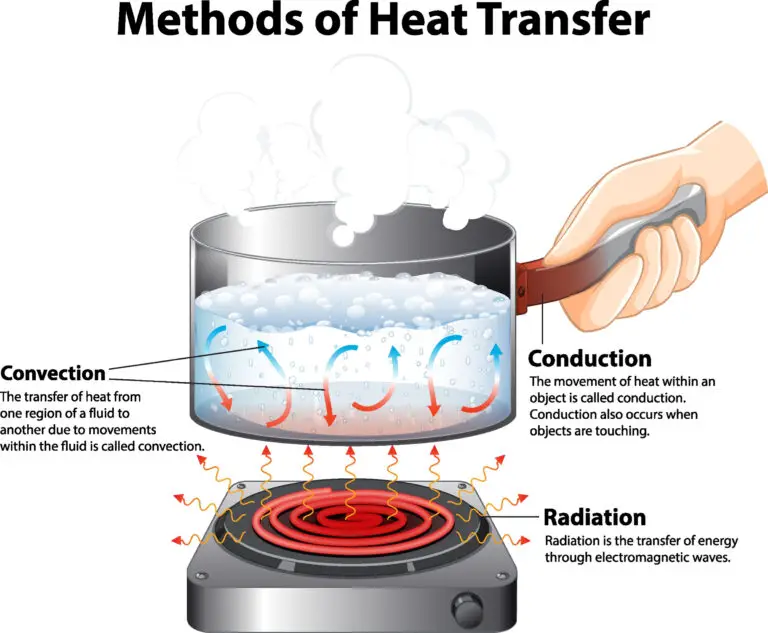Convection

Table of Contents
What is Convection?
Convection is a fundamental mechanism of heat and mass transfer in fluids, including liquids and gases. This process involves the movement of the fluid itself, carrying energy or substances from one location to another.
Types of Convection
- Natural Convection: This occurs due to the natural movement of fluid caused by temperature differences, leading to variations in density and gravitational forces acting on the fluid. It doesn’t require an external force and is commonly seen in geophysical phenomena, such as ocean currents and atmospheric circulation.
- Forced Convection: This happens when an external force, like a pump or fan, propels the fluid, causing it to move and transfer heat or mass. Forced convection is often used in engineering applications to enhance heat transfer, such as in cooling systems for electronic devices.
How Convection Works
Heat Transfer
The process starts when a region of the fluid is heated. As the fluid warms up, its particles gain kinetic energy and move more rapidly, causing them to spread out and decrease in density.
Density Differences and Fluid Movement
The decrease in density of the heated fluid makes it lighter compared to the surrounding cooler fluid. Due to the buoyancy effect, this warmer, less dense fluid rises. Conversely, the cooler fluid, being denser, sinks towards the heat source. This movement creates a flow pattern known as a convection current.
Formation of Convection Currents
As the rising warm fluid reaches a cooler area, it loses heat, becomes denser, and begins to sink. Simultaneously, the sinking cool fluid gets heated, becomes less dense, and rises. This continuous rising and sinking fluid cycle, driven by heat exchange and density differences, forms convection currents.
Transfer of Energy
Through these convection currents, energy is transferred from the hotter region to the cooler regions of the fluid. The physical movement of the fluid carries thermal energy, distributing heat throughout the fluid medium.
Rayleigh-Bénard Convection
Rayleigh-Bénard convection is a classical phenomenon in the study of fluid dynamics and heat transfer, providing a fundamental understanding of how convection currents form and behave. It occurs in a fluid layer that is heated from below and cooled from above. The temperature difference between the lower and upper boundaries of the fluid layer creates a thermal gradient, driving the convection process.
As the fluid near the bottom heats up, it expands, becomes less dense, and rises towards the cooler top. Upon cooling, the fluid contracts becomes denser and sinks back down. This cycle establishes a steady pattern of cell-like structures known as convection cells or Bénard cells. These cells are often hexagonal and create a regular pattern that can be observed on the surface of the fluid.
For Rayleigh-Bénard convection to occur, the temperature gradient across the fluid layer must exceed a critical value. This gradient is quantified by the dimensionless Rayleigh number, which depends on the temperature difference, the height of the fluid layer, the fluid’s properties (like thermal expansion coefficient, viscosity, and thermal diffusivity), and gravity. Convection begins when the Rayleigh number surpasses a critical threshold, leading to the onset of fluid motion.
Convection vs. Conduction
Conduction and convection are both modes of heat transfer but operate through different mechanisms:
Convection: As discussed, convection is the process of heat transfer in a fluid (liquid or gas) through the movement of the fluid itself. This movement, driven by temperature differences within the fluid, transfers heat from warmer to cooler areas. In convection, the heat is carried by the moving fluid particles, allowing for the efficient transport of thermal energy over larger distances within the fluid.
Conduction: In contrast, conduction is the process of heat transfer through direct contact between molecules within a material or between two materials in contact. In conduction, heat flows from regions of higher temperature to regions of lower temperature within the material without any actual movement of the material as a whole. This transfer occurs at the molecular or atomic level as kinetic energy is passed from one molecule or atom to another through vibrations and collisions.
Key differences include:
Medium of Transfer: Conduction typically occurs in solids, where particles are closely packed and can easily transfer energy through direct contact. Convection requires a fluid medium (liquids or gases) where the particles can move freely, allowing the fluid to carry heat as it flows.
Mechanism of Heat Transfer: Conduction involves the transfer of heat through direct molecular contact and does not involve mass movement, whereas convection involves the bulk movement of fluid, carrying heat with it.
Applications of Convection
Heat Transfer
Convection is a primary method for transferring heat in engineering and daily life. It’s fundamental in designing heating systems like furnaces and radiators, cooling systems like air conditioners and refrigerators, and cooking appliances like ovens and stovetops. In these systems, convection aids in distributing heat evenly and efficiently.
Atmospheric Phenomena
Convection in the Earth’s atmosphere significantly drives weather and climate patterns. Warm air rises, and cool air descends, creating convection currents that form clouds, drive wind patterns, and precipitate weather events like storms and rainfall.
Geological Processes
The Earth’s mantle experiences convection currents due to the heat from the core, causing the semi-fluid rock to move slowly. These movements are key to geological phenomena like plate tectonics, which shape the Earth’s surface through the movement of continental and oceanic plates, leading to the formation of mountains, volcanic activity, and earthquakes.
Oceanic Circulation
Oceanic convection currents are critical for oceanic circulation, driven by temperature and salinity differences in water masses. These currents help distribute heat around the planet, regulate climate, and transport nutrients, impacting marine life and ecosystems. Oceanic convection plays a role in global climate patterns, including phenomena like El Niño and La Niña.
Related Links
Heat
Energy
Radiation
Temperature